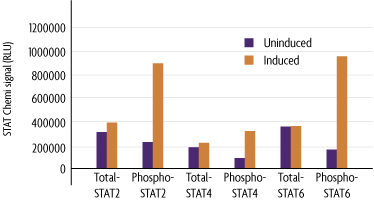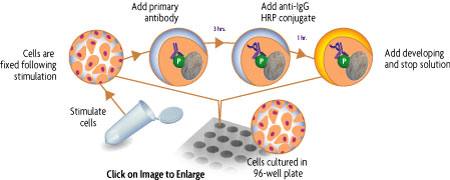THIS PRODUCT IS DISCONTINUED
Fast Activated Cell-based ELISA (FACE™) Kits provide a simple, sensitive method for detecting protein phosphorylation directly in the cell, without making extracts or performing electrophoresis and membrane blotting. These 96-well, high-throughput assays are available in both colorimetric and chemiluminescent formats for over 20 different targets (see list at right). For complete details, click the FACE™ Method tab below.
FACE STAT6 Kits provide 96 rxns each of 2 antibodies that enable you to monitor and compare the levels of both phosphorylated and total STAT6. The phospho-STAT6 antibody recognizes STAT6 only when phosphorylated at Tyr641, and does not cross-react with other sites. The total-STAT6 antibody recognizes STAT6 regardless of its phosphorylation state. Click the STAT Info tab below for data and more information.
| Name | Format | Cat No. | Price | |
|---|---|---|---|---|
| FACE™ STAT6 | 1 x 96 rxns | 48330 | Discontinued | |
| 5 x 96 rxns | 48830 | Discontinued | ||
| FACE™ STAT6 Chemi | 1 x 96 rxns | 48430 | Discontinued | |
| 5 x 96 rxns | 48930 | Discontinued | ||
| FACE™ STAT Manual |
| FACE™ Profile |
| Cell Biology Products Brochure |
| IsoCyte™ Application Note – Phospho-Protein Detection |
| MSDS: Sodium Azide |
| MSDS: Sulphuric Acid |
| MSDS: Thimersol |

Figure 1: Measurement of phosphorylated and total STAT.NIH/3T3 cells were cultured in 96-well plates and serum-starved for 16 hours. Cells were then treated with 50 ng/ml PDGF for 5 minutes and fixed. Total and phospho STAT2, STAT4 and STAT6 were each assayed in triplicate using the phospho and total STAT antibodies included in the FACE STAT Kits. Data was plotted after correction for cell number (performed through use of Crystal Violet).
Antibody Specificities
The phospho-STAT2 antibody is specific for phosphorylated STAT2 at Tyrosine 689 and does not cross-react with other sites. The total-STAT2 antibody recognizes STAT2 proteins regardless of the phosphorylation state. The phospho-STAT4 antibody is specific for phosphorylated STAT4 at Tyrosine 693 and does not cross-react with other sites. The total-STAT4 antibody recognizes STAT4 proteins regardless of the phosphorylation state. The phospho-STAT6 antibody is specific for phosphorylated STAT6 at Tyrosine 641 and does not cross-react with other sites. The total-STAT6 antibody recognizes STAT6 proteins regardless of the phosphorylation state.
STAT Overview
Signal transducers and activators of transcription (STAT) proteins are latent transcription factors that are activated by phosphorylation via tyrosine kinases. Over 35 different extracellular polypeptides activate Janus kinase associated receptors, leading to phosphorylation of Janus kinases and the subsequent phosphorylation of STAT proteins. Upon phosphorylation, the STAT proteins dimerize and migrate to the nucleus where they exert transcriptional activation. Phosphorylation of a single tyrosine localized around residue 700 is crucial for activation of each STAT family member. STAT1 is involved in the activation of IFNα and IFNγ genes, STAT2 in the activation of IFNα genes, STAT4 and STAT6 in T-helper cell development and STAT5 in milk production. Disruption of STAT functions in mouse leads to several defects such as immune deficiency (STAT1), embryonic lethality (STAT2), lack of gastrulation (STAT3), T-helper 1 cell dysfunction (STAT4), lack of lactation (STAT5A, 5B) and T-helper 2 cell dysfunction (STAT6). The disruption of STAT signaling blocks neoplastic transformation, thus making inhibitors of STAT proteins candidates for the treatment of cancer.
The FACE™ Method
In FACE, cells are cultured in 96-well plates and stimulated to induce the pathway of interest. Following stimulation, the cells are fixed rapidly, which preserves activation-specific protein modifications. Each well is then incubated with a primary antibody specific for the activated protein of interest. Subsequent incubation with secondary HRP-conjugated antibody and developing solution provides a colorimetric or chemiluminescent readout that is quantitative and reproducible (Figure 1). The number of cells in each well can be normalized easily with the provided Crystal Violet solution. FACE Kits also contain primary antibody specific for the native inactive protein, so you can monitor both native and activated protein levels in the same experiment. FACE eliminates cellular extractions, radioactive kinase assays, time-consuming Westerns and inefficient epitope interactions that occur on membranes. FACE is a highly sensitive high-throughput assay designed for detecting activated proteins within mammalian cells.
Figure 1: Flow chart of the FACE process.
Flow chart of the FACE in cell Western method that uses a cell based ELISA to measure the levels of the native and phospho forms of signaling proteins and kinases that are activated by phosphorylation.
Contents & Storage
Two (or ten) 96-well plates for culturing cells, 96 (or 5 x 96) rxns each of two primary antibodies (1 phospho-specific, 1 specific for native protein), HRP-conjugated secondary antibody, Quenching Solution, 1X Antibody Blocking Buffer, 1X Antibody Dilution Buffer, 10X PBS, 10% Triton X-100, 1% SDS Solution, Developing and Stop Solutions, and Crystal Violet Cell Quantification Solution. Storage conditions vary from room temperature to -20°C, see manual for details. All reagents are guaranteed stable for 6 months when stored properly.


